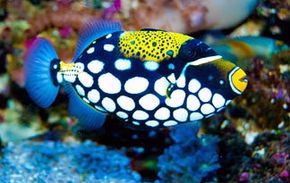 “Fish can taste without even opening their mouths.SEFSC Pascagoula Laboratory; Collection of Brandi Noble, NOAA/NMFS/SEFSC
“Fish can taste without even opening their mouths.SEFSC Pascagoula Laboratory; Collection of Brandi Noble, NOAA/NMFS/SEFSC
A fish is a water-dwelling animal that breathes through gills and has a backbone, fins and a two-chambered heart. If you’re the incurious sort, that may be all you care to know about them — other than perhaps which ones taste better with cocktail or tartar sauce. But for those of us who fancy fish, they’re endlessly fascinating creatures, about whom we can’t learn enough
They range from tiny creatures that would fit on a fingernail to monsters the size of cabin cruisers. They can sleep with their eyes open, taste without using their mouths and float without casting a shadow. Learn more fun fish facts on the following pages.
Contents
- You've Probably Never Seen the World's Most Common Fish
- The Biggest Fish is No Tough Guy
- The Tiniest Fish is Male
- Fish Have Head-to-tail Taste Buds
- Some Fish Can Swim Backwards
5: You've Probably Never Seen the World's Most Common Fish
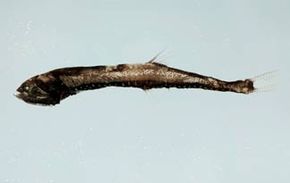 “The humble, homely, and very common, bristlemouth.Stockphoto/Thinkstock
“The humble, homely, and very common, bristlemouth.Stockphoto/Thinkstock
If you’re expecting it to be a tuna, flounder or goldfish, guess again. The most common type of fish on the planet is one humans rarely see. Why? Because it’s small, ingeniously camouflaged and lives between 100 and 250 fathoms down in the ocean. It’s the bristlemouth, a member of the genus Cyclothone.
The bristlemouth clan are humble, homely creatures with stubby bodies and tiny eyes, and they’re mostly mouth and fins. Size-wise, they’re unimposing. Most species grow to no more than three inches in length. But the bristlemouth has one outstanding piece of equipment: two rows of photophores, or light-emitting organs, on its underside, which it uses to prevent itself from a casting shadow its predators might spy. Its predators include shrimp, which gives you a sense of how puny this fish is.
4: The Biggest Fish is No Tough Guy
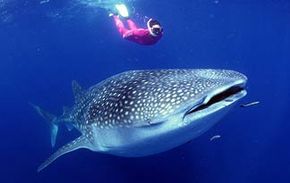 “The whale shark, the world’s largest fish, is pretty harmless.Hemera Technologies/Thinkstock
“The whale shark, the world’s largest fish, is pretty harmless.Hemera Technologies/Thinkstock
The big kahuna of the fish world is the whale shark (Rhincodon typus), which lives in semi-tropical and warm temperate waters around the world and grows to more than 65 feet, weighing nearly 40 tons. With its tremendous length, gigantic blunt head and polka-dot pattern, the whale shark looks like the prototype for Roy Scheider’s worst nightmare. In reality, the big fellas are pretty much harmless. They’re so docile, in fact, that they’ve been known to allow swimmers to hitch rides on their backs. They’re filter eaters, rather than biters, and feed on a diet of tiny plankton, small fishes, crustaceans and squid. They live to the age of about 70, unless humans harpoon them and grind them up into fish meal.
3: The Tiniest Fish is Male
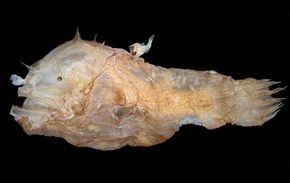 “After much debate, the male anglerfish is named the world’s smallest fish.Courtesy of Theodore W. Pietsch, University of Washington
“After much debate, the male anglerfish is named the world’s smallest fish.Courtesy of Theodore W. Pietsch, University of Washington
The title of world’s smallest fish is a matter of controversy. In 2006, the prestigious scientific journal of the UK’s Royal Society published an article touting the discovery of a lilliputian fish from the genus Paedocypris, which dwells in Sumatran swamps and is only 7.8 milimeters in length, or about a third of an inch. Soon after that, other scientists came forward to cite an even smaller fish that already had been described in the scientific literature: an Australian specimen of the stout infantfish (Schlindleria brevipinguis), which is 7.0 millimeters long.
But the tiniest of fish turns out to be a male anglerfish (Photocorynus spiniceps), discovered in the Philippines, that measures just 6.2 centimeters (about a quarter of an inch) from snout to tail. The male spiniceps is a parasite that spends its life fused to a much larger female. She takes care of all the work, like swimming and eating, while he just hangs on.
2: Fish Have Head-to-tail Taste Buds
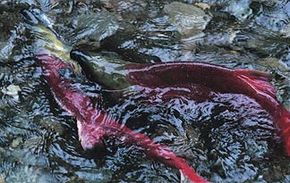 “Taste matters in the fish world. They are swimming in sophisticated palate, literally.DCL |
“Taste matters in the fish world. They are swimming in sophisticated palate, literally.DCL |
Unlike humans, fish don’t have 3-D vision. That’s because their eyes are on the opposite sides of their heads. But what they lack in binocular vision, they make up for with extremely acute interrelated senses of smell and taste, which they rely on to perceive their environment. Some fish use smell to help them find a safe place to lay their eggs. Migrating salmon can recognize the odor of their home stream. Sharks, rays, eels and salmon have such fine-tuned olfactory rosettes (the organs that detect scents) that they can smell chemical levels as low as one part per billion in the water around them.
Fishes’ ability to taste is similarly well-developed. Many species have taste buds not just on their tongues, but on their fins, face and tail area as well. They’re actually capable of tasting food before they have it in their mouths. Catfish have the most sophisticated palates of all. They’re literally covered from head to tail with taste buds. Even their whiskers have taste buds. That enables catfish to scavenge for food even in muddy, murky water.
1: Some Fish Can Swim Backwards
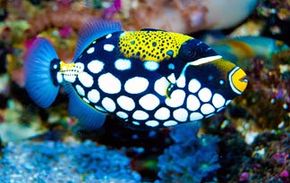 “The triggerfish may be one of the best fish dancers with forward and backward moves.SEFSC Pascagoula Laboratory; Collection of Brandi Noble, NOAA/NMFS/SEFSC
“The triggerfish may be one of the best fish dancers with forward and backward moves.SEFSC Pascagoula Laboratory; Collection of Brandi Noble, NOAA/NMFS/SEFSC
Remember the old line that Ginger Rogers was more talented than Fred Astaire because she had to do everything he did, backwards and in high heels? Well, most fish would be lousy dancers, and not just because they don’t have feet. The majority of them have an anatomical design that allows them to flex their bodies and move their tail, or caudal, fin to thrust themselves through the water. An area of muscle near to the tail generates most of the force. That’s a great way to swim forward in a hurry, but not so great for rear motion.
Some species, however, can mimic Ginger using different methods of locomotion. Triggerfish, members of the family Balistidae, for example, use a method called balistiform mode, in which they move by undulating their dorsal and anal fins. They have fins that are inclined so that they can thrust forward, which moves them backward through the water. The electric eel (Electrophorus electricus) is similarly nimble in both directions because it uses a form of locomotion called gymnotiform mode, which involves undulating its lengthy body and flapping its anal fins

